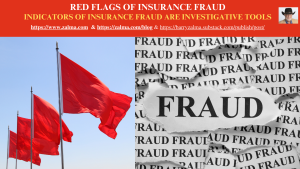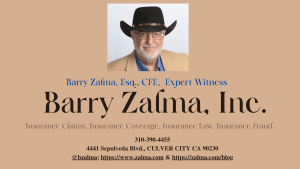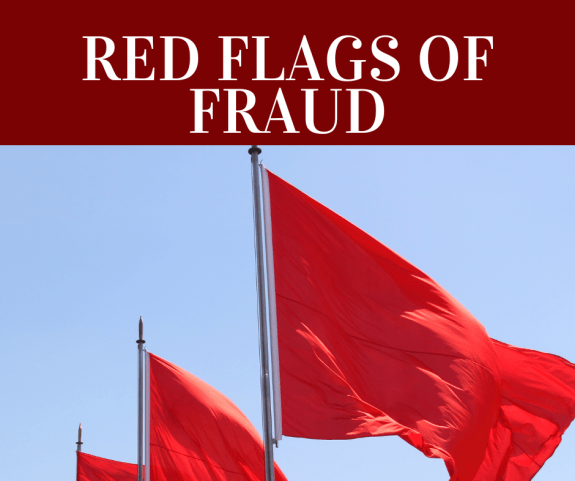Red Flags of Insurance Fraud

Post 4763
See the full video at https://rumble.com/v4ln1xr-red-flags-of-insurance-fraud.html and at https://youtu.be/xSnn0wy1yUU
Suspicious claims have common attributes. Insurers and their anti-fraud organizations have collated the common attributes into lists of indicators or red flags of fraud. The lists were created as training aids and to be used to determine whether further investigation is required to determine if a claim is legitimate or false and fraudulent. Continually growing, these lists are known as the “red flags” or “indicators” of fraud lists. There are many different categories, ranging from those associated with the claim itself or with insureds to indicators of specific types of fraud, such as bodily injury fraud or arson for profit.
If, when assessing a claim, three or more red flags are found the need for further investigation should be considered and evaluated by the claims person, a supervisor and the insurer’s special investigative unit. The existence of red flags does not mean a fraud has occurred. Red flags are only a signal to the adjuster to investigate further so that the suspicion may be either removed or confirmed. It is not any single indicator that alerts the adjuster to the possibility of a fraudulent claim but a combination of the red flag or red flags discovered coupled with the results of the thorough claims investigation.
Although the existence of multiple red flags should trigger an investigation, failure to investigate has been held to be reasonable as long as there are no patent inaccuracies or actual knowledge of false representations.
Red Flags
More than one mortgage,
late payments,
divorce,
prior claims,
multiple claims,
problems affecting title to the property,
over-insurance,
an increase in insurance coverage right before the claim,
recent cancellations of insurance held with prior insurers,
liens,
threats of foreclosure on the property,
lawsuits, and
recent job transfers.
As the Nebraska Department of Insurance states in its booklet, Fraud Detection Hints, it is “important to remember that the … possible ‘red flags’ [indicate] that there may be some evidence consistent with an insurance fraud scheme. Any one or two of these by themselves may not raise your suspicions; however, when you have several of these hints (red flags) present or a pattern begins to emerge, you should investigate further or forward your suspicion to the Insurance Fraud Prevention Division.” [O’Donnell v. Allstate Insurance Co., 734 A.2d 901, 1999 PA Super 161 (Pa. Super., 1999); and LeForge v. Nationwide Mut. Fire Ins. Co., 82 Ohio App. 3d 692 (Ohio App., 1992).]
Red Flags Common to a Claim
An adjuster should consider further investigation if a claim occurs:
shortly after the issuance of the policy;
shortly after the limits of the policy are increased;
in an insured’s first insurance;
shortly before the expiration of a policy;
within days of a notice of cancellation being served; or
on a policy acquired from an agent far from the insured’s home or business
Red Flags Connected with the Insured or Claimant
Adjusters evaluate the manner in which the insured makes a claim. A few red flags that may raise suspicions include some of the following when the insured or claimant:
retains or is represented by counsel on the day of the loss;
does not want to retain counsel;
is represented by a public adjuster on the day of the loss;
wants a settlement approved quickly;
does not want the claim to go to a supervisor, regional office, or claims committee for authority;
is exceedingly cooperative and undemanding;
is exceedingly demanding and threatens a bad faith suit from the date of first contact;
demands a proof of loss form at the initial meeting;
is familiar with insurance claims terminology;
asks for the claims manager by name;
is familiar with the adjuster’s authority limits, and wants to settle for a sum within those limits;
handles all business in person (thus avoiding mail and potential prosecution for violation of federal mail fraud statutes);
provides an address that is a post office box, mail drop, or hotel; or
reduces the demand for settlement when it is suggested by the adjuster that he or she file suit.
The adjuster or investigator should also pay attention to the insured’s or claimant’s history and background, including their financial situation.
Red Flags Concerning the Insured
The insured has lived at his current address less than six months.
The insured has been with current employer less than six months.
The insured has a previous history of losses.
The insured cancels scheduled appointments with the adjuster for statements and/or Examination Under Oath.
The insured is employed with an insurer.
The insured is unusually aggressive and pressures for a quick settlement.
The insured does not have a telephone.
The insured’s telephone number is only a mobile cellular phone.
The insured is difficult to contact.
The insured claims to be self-employed but is vague about the business, and his responsibilities.
The insured is very knowledgeable about claims process and Insurance terminology.
The insured offers inducement for a quick settlement.
The insured is unsolicited new, walk-in business, not referred by an existing policyholder.
The insured’s address is not consistent with his employment or income.
The insured only gives a post office box as his address.
The insured is unemployed or in a transient occupation.
The insured seeks a copy of the policy before agreeing to insure.
The insured is vague about loss.
The insured’s report of loss is inconsistent.
The insured has a selective memory.
The insured has financial difficulties.
Fraud by Insurers
Insurers and their officers commit fraud in many ways, including, but not limited to:
Submission of falsified financial statements.
Misuse of company funds.
Issuance of unauthorized insurance policies.
Insurance plans not authorized by the state Departments of Insurance.
Individuals not licensed to do the business of insurance.
Fraudulent group/individual health plans.
Some examples of fraud by insurers claimed under homeowners policies:
Insisting that the insured allow the insurer to generate the loss inventory after a covered loss.
Issuing policies with a declaration page showing policy limits that the insurer knows is higher than the actual cash value or replacement cost of the property, the risk of loss of which is insured, to take premium for a greater risk than that actually taken.
Using economic coercion to force the claimant to use their preferred repair vendor.
Undercutting market rates to lure employers to acquire Workers’ Compensation insurance while failing to properly maintain sufficient funds in reserve to cover claims.
Use of an unqualified or dishonest Medical Examiner to avoid payment of claims.
Use of unethical defense attorneys to avoid payments of claims.
Use of unethical private investigators.
Use of Special Investigative Unit investigators whose only purpose is to deny claims rather than in an effort to avoid fraud.
Red flags are not evidence. They are often contradictory. They are evidence that a fraud might be happening and require, when more than three or four red flags show up in an investigation that it is time to refer the claim to the insurer’s Special Investigative Unit to determine if there exists admissible evidence that a fraud has been attempted.
 (c) 2024 Barry Zalma & ClaimSchool, Inc.
(c) 2024 Barry Zalma & ClaimSchool, Inc.
Please tell your friends and colleagues about this blog and the videos and let them subscribe to the blog and the videos.
Subscribe to my substack at https://barryzalma.substack.com/publish/post/107007808
Go to X @bzalma; Go to Newsbreak.com https://www.newsbreak.com/@c/1653419?s=01; Go to Barry Zalma videos at Rumble.com at https://rumble.com/c/c-262921; Go to Barry Zalma on YouTube- https://www.youtube.com/channel/UCysiZklEtxZsSF9DfC0Expg.
Go to the Insurance Claims Library – https://lnkd.in/gwEYk
Like this:
Loading…
Related
About Barry Zalma
An insurance coverage and claims handling author, consultant and expert witness with more than 48 years of practical and court room experience.








